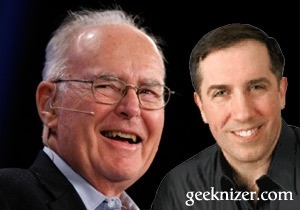 Moore’s law has been valid for decades after Gorden Moore, co-founder of Intel corp stated is precious theory. The law talks about the number of transistors that can be inexpensively placed on an integrated circuit doubles approximately every 18 months. A new theory is now considered to be even more accurate and holds true for generations to come. Koomey’s law, created by Dr. Jonathan Koomey, consulting professor of civil and environmental engineering at Stanford University. Koomey has a new idea that seems to have validity in the age of smartphones, tablets and other battery-reliant devices — Power consumption is the metric that should govern future processor design, rather than raw power. Koomey has been studying power consumption of semi-counductors since their discovery, and he is the best person to talk about it. According to Koomey’s law:
Moore’s law has been valid for decades after Gorden Moore, co-founder of Intel corp stated is precious theory. The law talks about the number of transistors that can be inexpensively placed on an integrated circuit doubles approximately every 18 months. A new theory is now considered to be even more accurate and holds true for generations to come. Koomey’s law, created by Dr. Jonathan Koomey, consulting professor of civil and environmental engineering at Stanford University. Koomey has a new idea that seems to have validity in the age of smartphones, tablets and other battery-reliant devices — Power consumption is the metric that should govern future processor design, rather than raw power. Koomey has been studying power consumption of semi-counductors since their discovery, and he is the best person to talk about it. According to Koomey’s law:
“The idea is that at a fixed computing load, the amount of battery you need will fall by a factor of two every year and a half” which will shape the future of mobile computing in all forms.
Koomey’s law is more consumer centric, which says that Energy efficiency and thus, battery life is becoming more of a concern than the raw power of new devices thanks to the continuing rise of smartphones, tablets and notebooks. Till very recently, both Moore’s law and Koomey’s law had been valid, but Moore’s law had been invalidated according to several scientists.
Typically, performance improvement can be achieved by either overclocking the chipset ( by delivering more power to the transistors) thus generating more heat, or by simply adding more transistors to meet the new performance requirements. Both the problems of performance and energy efficiency have been answered thus far with a single solution: reducing the size of transistors. This allows for more of them to be placed on a chipset and reduces each transistor’s energy and heat mitigation requirements. e.g. a 45nm chip is more power hungry than a 22nm chip, and so on; Size difference is obvious.
Energy efficiency of transistors is a better concept and benchmark to measure improvements over years.
“This is a fundamental characteristic of information technology that uses electrons for switching… It’s not just a function of the components on a chip”. It stands to reason then, that future technologies will likely be based on this same premise, and thus conform to the theory.
Physicist Richard Feynman tells us Koomey’s theory would hold true for decades to come. In 1985, Richard analyzed the electrical requirements of computers and estimated that the technology could theoretically improve by a factor of one hundred billion (100,000,000,000) beforeit reaches the limit. So far, we’ve only seen an improvement of around a factor of forty thousand (40,000). Whatever may happen, both Moore and Koomey believe that a technology that efficiently delivered boundless processing power would be magical indeed. Arthur C. Clarke’s third law “Any sufficiently advanced technology is indistinguishable from magic”.
We write latest and greatest in Tech Guides, Apple, iPhone, Tablets, Android, Open Source, Latest in Tech, subscribe to us@geeknizer on Twitter OR on Facebook Fanpage:
a WordPress rating system
a WordPress rating system
